
Gartior
Ask a doctor about a prescription for Gartior

How to use Gartior
Leaflet accompanying the packaging: patient information
Gartior, 18 micrograms/dose, powder for inhalation in a hard capsule
Tiotropium
You should carefully read the contents of the leaflet before using the medicine, as it contains important information for the patient.
- You should keep this leaflet, so that you can read it again if you need to.
- If you have any doubts, you should consult a doctor or pharmacist.
- This medicine has been prescribed specifically for you. Do not pass it on to others. The medicine may harm another person, even if their symptoms are the same.
- If the patient experiences any side effects, including any side effects not listed in this leaflet, they should tell their doctor or pharmacist. See section 4.
Table of contents of the leaflet
- 1. What is Gartior and what is it used for
- 2. Important information before using Gartior
- 3. How to use Gartior
- 4. Possible side effects
- 5. How to store Gartior
- 6. Contents of the packaging and other information
1. What is Gartior and what is it used for
Gartior, 18 micrograms/dose, powder for inhalation in a hard capsule contains the active substance tiotropium and belongs to a group of medicines used to treat obstructive airway diseases, inhaled medicines, anticholinergic medicines.
Gartior makes it easier for people with chronic obstructive pulmonary disease (COPD) to breathe.
COPD is a chronic lung disease that causes shortness of breath and coughing. The name COPD is associated with chronic bronchitis and emphysema. COPD is a chronic disease, so Gartior should be taken every day, and not just when breathing problems or other COPD symptoms occur.
Gartior is a long-acting bronchodilator that helps to dilate the airways and facilitate the passage of air into and out of the lungs. Regular use of Gartior may also help reduce persistent shortness of breath associated with the disease and help reduce the impact of the disease on daily life. Daily use of Gartior will also help prevent sudden, short-term worsening of COPD symptoms, which can last for several days. The effect of the medicine lasts for 24 hours, so it should be taken only once a day.
Information on the correct dosing of Gartior can be found in the further part of the leaflet in point 3. How to use Gartior and the Instructions for use.
2. Important information before using Gartior
When not to use Gartior
Warnings and precautions
Before starting to use Gartior, you should discuss it with your doctor or pharmacist.
- You should consult a doctor if you have narrow-angle glaucoma, prostate problems, or difficulty urinating.
- If you have kidney function disorders, you should consult a doctor.
- Gartior is indicated for maintenance therapy in patients with chronic obstructive pulmonary disease. It should not be used to treat sudden attacks of shortness of breath or wheezing.
- After using Gartior, immediate allergic reactions, such as rash, swelling, itching, wheezing, or shortness of breath, may occur. In this case, you should contact your doctor immediately.
- Immediately after using inhaled medicines, such as Gartior, you may experience a feeling of chest tightness, coughing, wheezing, or shortness of breath. In this case, you should contact your doctor immediately.
- You should be careful not to inhale the powder into your eyes, as it may cause the occurrence or worsening of symptoms of narrow-angle glaucoma, which is an eye disease. Eye pain or discomfort, blurred vision, seeing a rainbow-colored halo around a light source, or changed color vision, along with eye redness, may be a sign of acute narrow-angle glaucoma. Eye disorders may be accompanied by headache, nausea, and vomiting. If symptoms of narrow-angle glaucoma occur, you should stop using tiotropium and contact your doctor immediately, preferably an ophthalmologist.
- Dryness of the oral mucosa occurring during the use of the medicine, related to its anticholinergic effect, may cause tooth decay over a longer period, so you should remember to maintain oral hygiene.
- If you have had a heart attack in the last 6 months, or if you have had unstable or life-threatening heart rhythm or severe heart failure in the last year, you should inform your doctor. It is important to make the right decision about whether Gartior can be used in your case.
- Gartior should not be used more than once a day.
Children and adolescents
Gartior is not recommended for children and adolescents under 18 years of age.
Gartior and other medicines
You should tell your doctor or pharmacist about all medicines you are currently taking, or have recently taken, and about medicines you plan to take.
You should inform your doctor or pharmacist about other medicines used to treat lung disease, such as ipratropium or oxytropium.
No interactions have been reported when taking Gartior with other medicines used to treat COPD, such as inhaled rescue medicines, e.g. salbutamol, methylxanthines, e.g. theophylline, and oral and inhaled steroids, e.g. prednisolone.
Pregnancy and breastfeeding
If you are pregnant or breastfeeding, think you may be pregnant, or plan to have a baby, you should ask your doctor or pharmacist for advice before taking this medicine. You should not take this medicine unless your doctor has told you to.
Driving and using machines
If you experience dizziness, blurred vision, or headache, these conditions may affect your ability to drive and use machines.
Gartior contains lactose
If you have been told that you have an intolerance to some sugars, or an allergy to milk proteins (which may be present in small amounts in the lactose monohydrate ingredient), you should contact your doctor before taking this medicine.
3. How to use Gartior
This medicine should always be used as directed by your doctor or pharmacist. If you are unsure, you should consult your doctor or pharmacist.
The recommended dose is the inhalation of the contents of one capsule (18 micrograms of tiotropium) once a day.
You should take 2 inhalations from the same capsule (see the "Instructions for use" section at the end of this leaflet).
You should not take more than the recommended dose.
Gartior is not recommended for children and adolescents under 18 years of age.
You should take the capsule at the same time every day. This is important because Gartior works for 24 hours.
The capsules can only be used for inhalation and should not be taken orally. The capsules should not be swallowed.
The Vertical-Haler inhaler, into which the Gartior capsule is inserted, pierces the capsule, allowing the powder to be inhaled.
You should make sure you have an inhaler and use it correctly. The instructions for using the inhaler are at the end of this leaflet.
You should make sure that air is not exhaled into the Vertical-Haler inhaler.
If you have any difficulties with using the Vertical-Haler inhaler, you should contact your doctor, nurse, or pharmacist to show you the correct way to use it.
The Vertical-Haler inhaler should be cleaned once a week. The instructions for cleaning the inhaler are at the end of this leaflet.
When using Gartior, you should be careful not to inhale the powder into your eyes. This may cause blurred vision, eye pain, and/or eye redness. You should rinse your eyes with warm water and contact your doctor immediately.
Using a higher dose of Gartior than recommended
If you use more than 1 Gartior capsule per day, you should contact your doctor immediately. You may be at increased risk of side effects, such as dryness of the oral mucosa, constipation, difficulty urinating, rapid heart rate, or blurred vision.
Missing a dose of Gartior
If you forget to take a dose, you should take it as soon as you remember.
Never take two doses at the same time or on the same day. The next dose should be taken at the usual time.
Stopping the use of Gartior
Before stopping the use of Gartior, you should consult your doctor or pharmacist.
After stopping the use of Gartior, COPD symptoms may worsen.
If you have any further doubts about the use of this medicine, you should consult your doctor or pharmacist.
4. Possible side effects
Like all medicines, this medicine can cause side effects, although not everybody gets them.
The side effects listed below were reported by patients taking this medicine. Side effects are listed by frequency: common, uncommon, rare, or frequency not known.
Common (may affect up to 1 in 10 people):
- dryness of the oral mucosa: usually mild
Uncommon (may affect up to 1 in 100 people):
- dizziness
- headache
- taste disorders
- blurred vision
- irregular heartbeat (atrial fibrillation)
- pharyngitis
- hoarseness (dysphonia)
- cough
- heartburn (gastroesophageal reflux disease)
- constipation
- fungal infections of the mouth and throat (oral and pharyngeal candidiasis)
- rash
- difficulty urinating (urinary retention)
- painful urination
Rare (may affect up to 1 in 1,000 people):
- sleep disorders (insomnia)
- seeing a rainbow-colored halo around a light source or changed color vision, along with eye redness (glaucoma)
- increased eye pressure
- irregular heartbeat (supraventricular tachycardia)
- rapid heart rate (tachycardia)
- feeling of rapid heartbeat (palpitations)
- chest tightness associated with coughing, wheezing, or shortness of breath occurring immediately after inhalation (bronchospasm)
- nasal bleeding
- laryngitis
- sinusitis
- intestinal obstruction or lack of bowel movements (intestinal obstruction, including paralytic ileus)
- gingivitis
- glossitis
- difficulty swallowing (dysphagia)
- stomatitis
- nausea
- allergic reactions, including anaphylaxis
- severe allergic reaction, which can cause swelling in the face or throat (angioedema)
- hives
- itching
- urinary tract infections
Frequency not known (frequency cannot be estimated from the available data):
- reduced water content in the body (dehydration)
- tooth decay
- severe allergic reactions (anaphylactic reactions)
- infections or ulcers of the skin
- dry skin
- joint swelling
Severe side effects, such as allergic reactions, which can cause swelling in the face or throat (angioedema), or other allergic reactions (such as a sudden drop in blood pressure or dizziness) may occur. Additionally, as with other inhaled medicines, some patients may experience unexpected chest tightness, coughing, wheezing, or shortness of breath immediately after inhalation (bronchospasm). If you experience any of these symptoms, you should contact your doctor immediately.
Reporting side effects
If you experience any side effects, including any side effects not listed in this leaflet, you should tell your doctor, pharmacist, or nurse.
Side effects can be reported directly to the Department of Adverse Reaction Monitoring of Medicinal Products, Medical Devices, and Biocidal Products:
Al. Jerozolimskie 181C, 02-222 Warsaw
tel.: +48 22 49 21 301, fax: +48 22 49 21 309
website: https://smz.ezdrowie.gov.pl
Side effects can also be reported to the marketing authorization holder.
Reporting side effects will help to gather more information on the safety of the medicine.
5. How to store Gartior
The medicine should be stored out of sight and reach of children.
Do not use this medicine after the expiry date stated on the carton or blister after: EXP. The expiry date refers to the last day of the month stated.
The Vertical-Haler inhaler should be discarded after 90 days of first use.
The capsule should be used immediately after opening the blister.
Do not store above 30°C.
Medicines should not be disposed of via wastewater or household waste. You should ask your pharmacist how to dispose of medicines that are no longer needed. This will help protect the environment.
6. Contents of the packaging and other information
What Gartior contains
The active substance is tiotropium. Each capsule contains 22.5 micrograms of tiotropium bromide monohydrate, which corresponds to 18 micrograms of tiotropium.
The delivered dose during inhalation, from the mouthpiece of the Vertical-Haler inhaler, contains 10 micrograms of tiotropium.
The other ingredients are lactose monohydrate (which may contain small amounts of milk proteins), gelatin, purified water, macrogol 4000, titanium dioxide (E 171), yellow iron oxide (E 172), and brilliant blue FCF (E 133).
What Gartior looks like and contents of the pack
Gartior, 18 micrograms/dose, powder for inhalation in a hard capsule, is a non-transparent green gelatin capsule containing a white powder.
A blister pack of 10 capsules.
Vertical-Haler is a single-dose inhaler with an orange mouthpiece and a white body. It is made of acrylonitrile-butadiene-styrene (ABS) polymer and stainless steel.
The materials that come into contact with the medicine during inhalation are: stainless steel 304 (needles piercing the capsule), acrylonitrile-butadiene-styrene-ABS (part of the mouthpiece and capsule chamber).
Available pack sizes:
- Carton containing 30 capsules (3 blisters) and a dry powder inhaler
- Carton containing 60 capsules (6 blisters) and a dry powder inhaler
- Carton containing 90 capsules (9 blisters) and a dry powder inhaler
- Carton containing 30 capsules (3 blisters)
- Carton containing 60 capsules (6 blisters)
Not all pack sizes may be marketed.
Marketing authorization holder
Glenmark Pharmaceuticals s.r.o.
Hvězdova 1716/2b
140 78 Prague 4
Czech Republic
Manufacturer/Importer
Pharmadox Healthcare Limited
Kw20a Kordin Industrial Park
Paola, PLA 3000
Malta
Glenmark Pharmaceuticals s.r.o.
Fibichova 143
566 17 Vysoké Mýto
Czech Republic
This medicine is authorized in the Member States of the European Economic Area under the following names:
For more information about this medicine, you should contact your local representative of the marketing authorization holder:
| Country | Medicine name |
| Czech Republic | Gartior |
| Poland | Gartior |
| Slovakia | Tiotropium Glenmark |
Glenmark Pharmaceuticals Sp. z o. o.
ul. Dziekońskiego 3
00-728 Warsaw
Tel: +48 22 35 12 500
Email: [email protected]
Date of last revision of the leaflet:
Medical device: Dry powder inhaler
- (English: DPI - Dry Powder Inhaler) Trade name: Vertical-Haler
Parts of the inhaler:
A) Mouthpiece D) Side button
B) Mouthpiece E) Open space
C) Chamber F) Capsule chamber
- 1) Removing the mouthpieceWhen using the inhaler, hands must be clean and dry. Hold the base of the inhaler firmly and remove the mouthpiece from the side, as shown below. (Fig. 1).


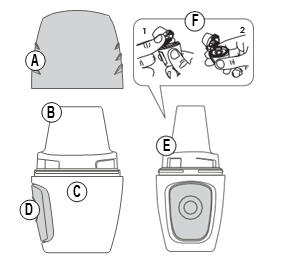




Before use:
The inhaler has been designed to assist with the inhalation of inhaled medicines in the form of a dry powder contained in capsules; such a device is activated by inhalation (inhalation-activated dry powder inhaler - DPI). The capsules containing the medicine are stored separately from the inhaler.
Each capsule containing a single dose should be placed in the inhaler chamber only when it is to be used.
After placing the capsule in the inhaler chamber and piercing it with the button, just before inhalation, the patient can start inhaling the medicine.
The inhaler should only be sold with the medicine.
Contraindications:
Patients who are unable to control their breathing on their own.

- 3) Removing the capsuleRemove the protective foil to remove the capsule from the blister pack (Fig. 3).
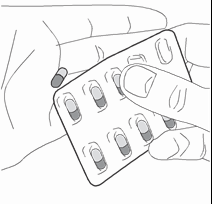
- 4) Placing the capsuleHold the open inhaler vertically. Place the capsule into the chamber (Fig. 4).
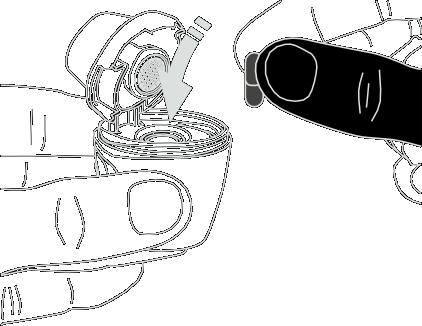
- 5) Checking the correct position of the capsuleThe capsule should be in the recess of the chamber (Fig. 5).
- 6) Closing the Vertical-Haler inhalerHold the Vertical-Haler inhaler vertically and close the mouthpiece. The "click" sound confirms that the Vertical-Haler inhaler has been properly closed (Fig. 6).
- 8) Taking a deep exhalationHold the inhaler away from your mouth and take a calm and deep exhalation (Fig. 9). Hold your breath.
DO NOT inhale into the Vertical-Haler inhaler. Moist air inhaled into the inhaler
may reduce the inhaled dose.
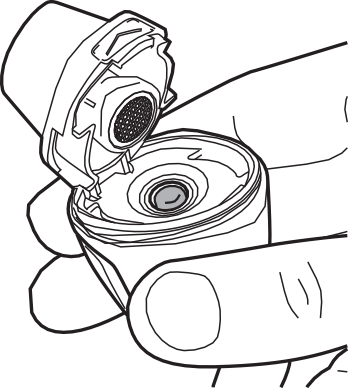
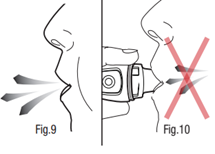
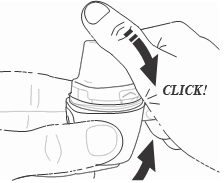

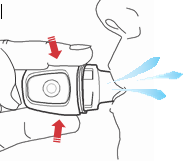



- 10) Holding the breathHold your breath for at least 10 seconds. Remove the inhaler from your mouth, then breathe normally (Fig. 9). This ensures that the medicine settles in the lungs. Repeat steps 8-10 to ensure that all the medicine has been administered.



- 11) Checking the empty capsuleOpen the Vertical-Inhaler and check if there is any powder left in the capsule. If the powder is still in the capsule, repeat steps 8-11.
- 12) Emptying the Vertical-Haler inhalerRemove the empty capsule (Fig. 13). The capsule may have broken into small fragments that may have entered your mouth or throat. Do not worry, as the capsule material is edible and harmless.
- 13) Cleaning the Vertical-Haler inhalerThe Vertical-Haler inhaler should be cleaned once a week. Clean the mouthpiece and capsule chamber with a clean, dry cloth. Alternatively, you can use a soft, clean brush to remove any residue that may have remained inside the inhaler. Close the Vertical-Haler inhaler.
You should put the mouthpiece cover back on the mouthpiece to protect the device from contamination.
DO NOT use water or other aggressive detergents to clean the device.
- 14) Rinsing the mouthRinse your mouth with water, do not swallow the water.
- 15) Disposing of the deviceThe Vertical-Inhaler is intended for use only with the supplied medicine and no other. If you receive a new package with a new Vertical-Haler inhaler, remember to dispose of the old inhaler.
Additional precautions:
DO NOTshare the Vertical-Haler inhaler with other people. There is a serious risk of cross-infection.
You can dispose of it with other household waste.
The inhaler should only be used with the supplied medicine, as instructed.
DO NOTopen the capsule and touch the powder.
DO NOTplace more than one capsule in the inhaler chamber or place two different medicines.
Noise in the room may make it difficult to hear if the device is working properly. It is recommended to use the device in a quiet room.
For additional information on the use of the inhaler, you should contact your doctor or pharmacist.
DO NOTdisassemble the inhaler.
If you experience any problems with the use of the medical device, you should return it to the marketing authorization holder or its representative in packaging that ensures the physical integrity of the device.
All serious incidents that occurred after using the medical device should be reported to the marketing authorization holder with a marketing authorization and to the relevant national supervisory authority.
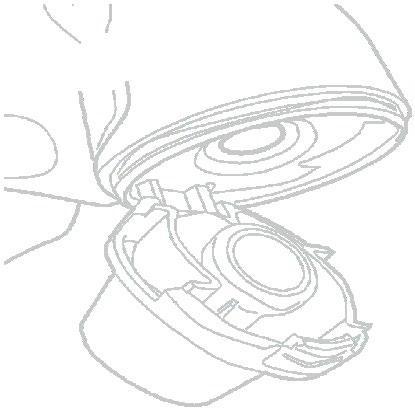

- Country of registration
- Active substance
- Prescription requiredYes
- ImporterGlenmark Pharmaceuticals s.r.o. Pharmadox Healthcare Limited
- This information is for reference only and does not constitute medical advice. Always consult a licensed doctor before taking any medication. Oladoctor is not responsible for medical decisions based on this content.
- Alternatives to GartiorDosage form: Powder, 18 mcgActive substance: tiotropium bromideManufacturer: Ferrer Internacional, S.A.Prescription requiredDosage form: Powder, 10 mcgActive substance: tiotropium bromideManufacturer: Actavis Ltd. Laboratorios Liconsa S.A. Teva Operations Poland Sp. z o.o. Teva Pharma B.V.Prescription requiredDosage form: Powder, 18 mcg/measured doseActive substance: tiotropium bromidePrescription not required
Alternatives to Gartior in other countries
The best alternatives with the same active ingredient and therapeutic effect.
Alternative to Gartior in Ukraine
Alternative to Gartior in Spain
Online doctors for Gartior
Discuss dosage, side effects, interactions, contraindications, and prescription renewal for Gartior – subject to medical assessment and local rules.














